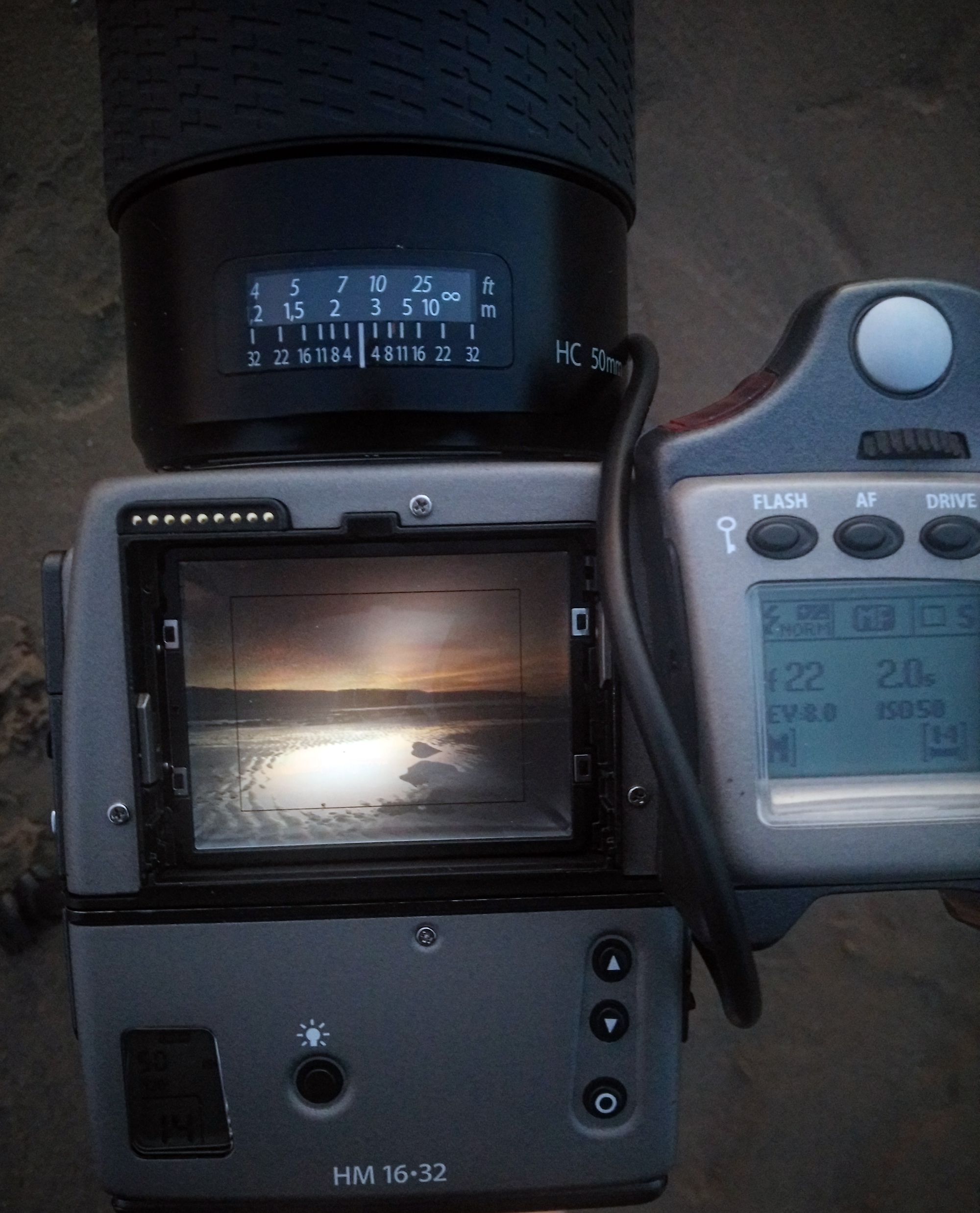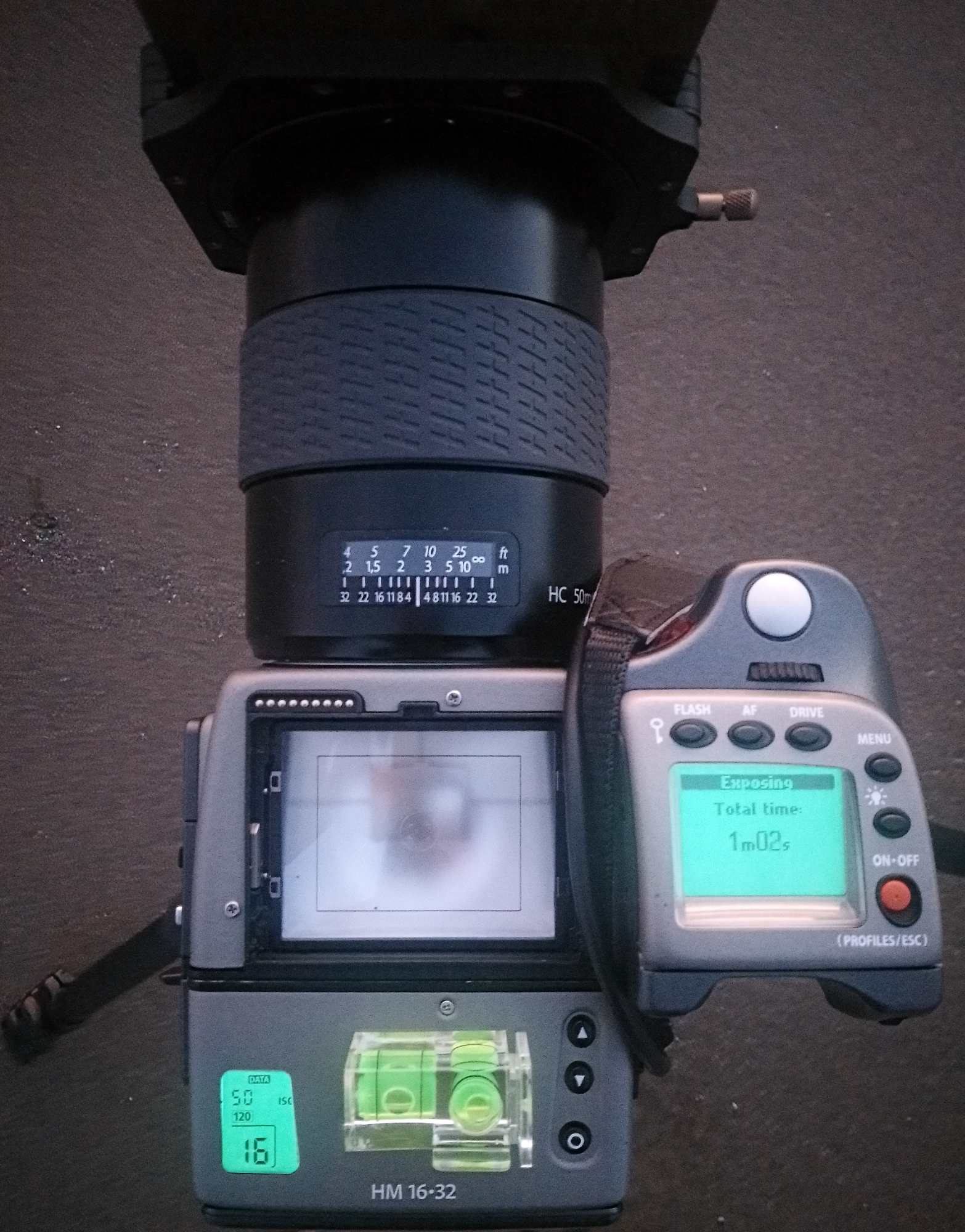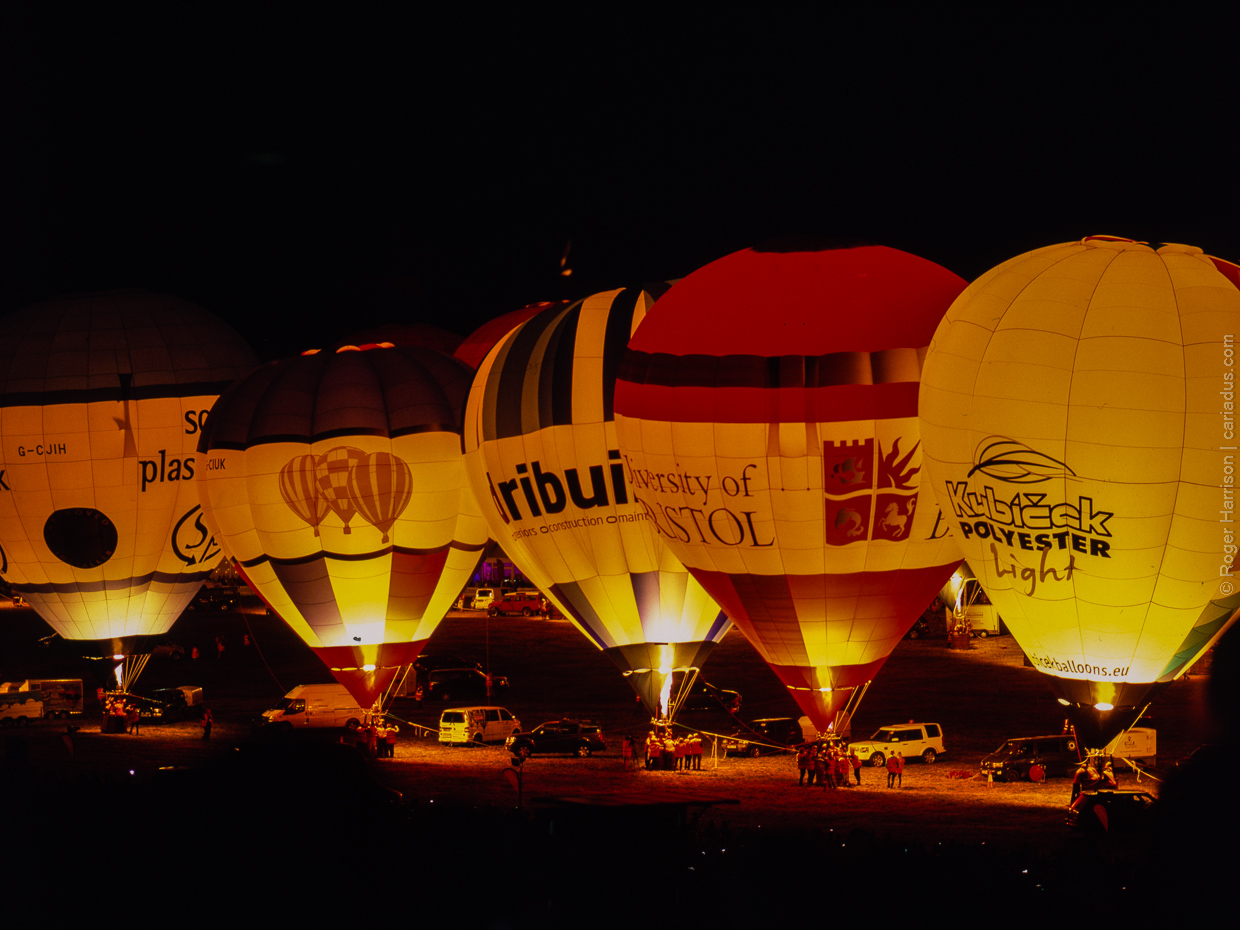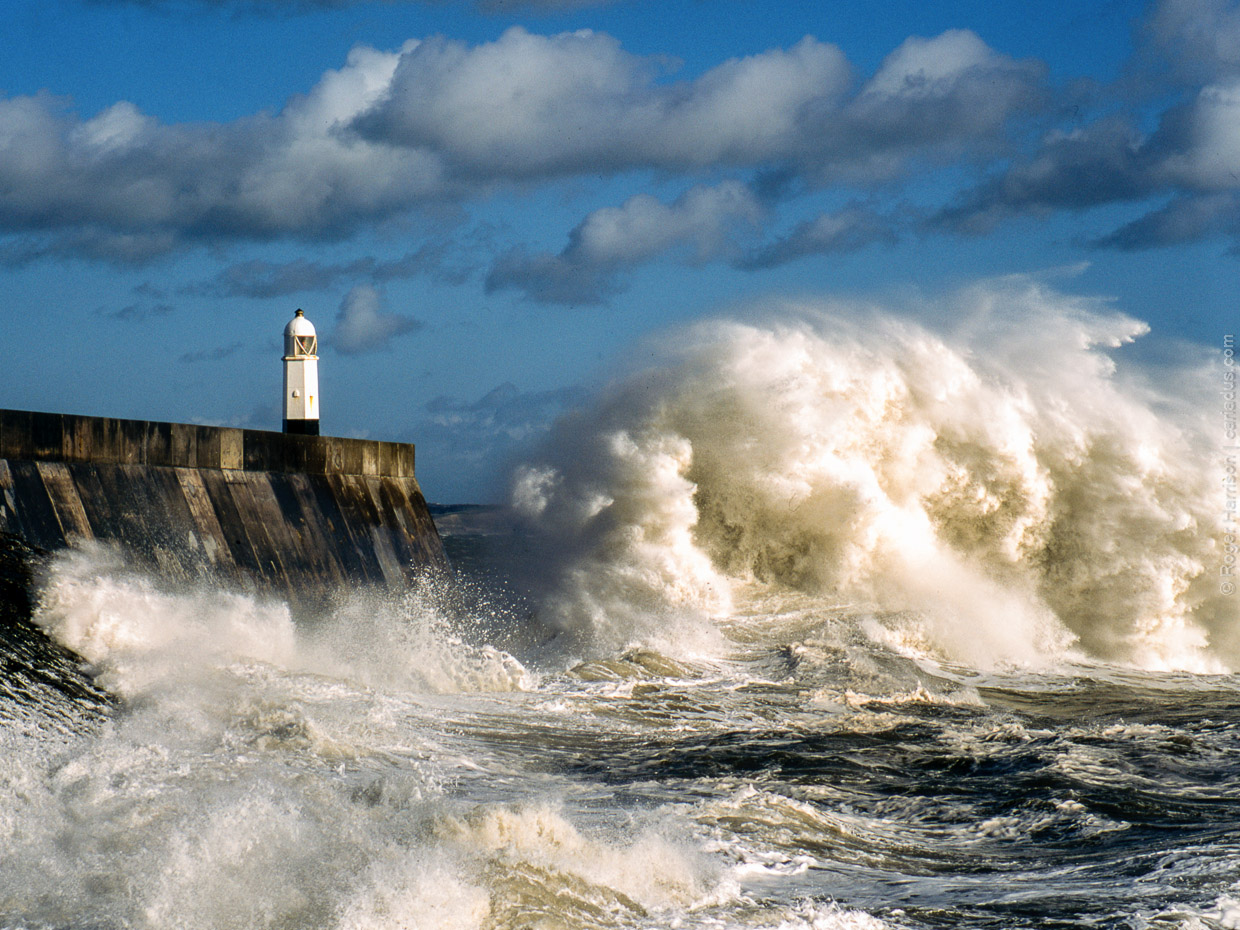I think the Hasselblad H System gets overlooked by film users. It tends to be associated with digital photography, but the H1 makes an excellent film camera.
The H1 in action on the beach
I've had mine for just over 6 months now and it's become my most used camera by a long way. My reason for buying an H1 can be summed up in one word: versatility. I was using three different camera systems previously - a Hasselblad V System, Olympus OM system and Contax G (I do find autofocus handy on occasion).
I love the Hasselblad V System and my 500EL/M was my most used camera, but there are situations where it is too cumbersome and slow, and for those situations I would use either the Olympus or Contax instead. I started thinking wouldn't it be good to have one camera system that could take care of most of my photographic needs instead of three? And the H1 could be that camera.
What I was hoping for from the H1 was a camera that would be good to use on a tripod, but would also be good to use handheld in fast moving situations. And it certainly delivers on both counts.
For tripod use you can get information about shutter speed, aperture and so on either through the viewfinder or on the LCD screen on the top of the grip. The LCD screen not only gives shutter speed and aperture, but also EV (Exposure Value). For someone used to metering in EV on the Zeiss V System lenses that makes life much easier. Usually I will set the aperture that I want, decide on the EV based on my hand held spot meter and adjust the shutter speed until I reach the desired EV. I find that much easier than having to translate EV to a shutter speed/aperture combination. The LCD screen can also be illuminated which for me is a big plus as I'm often photographing in low light and sometimes near darkness.
The H1 without prism during an expsoure with the main LCD illuminated showing the time elapsed. The film back LCD illuminates as well.
The H1 works really well for long exposures. For exposures longer than 1 second you can either set the shutter speed on the dial (up to 18 hours!), or you have a choice of time or bulb mode. In bulb mode the time that the shutter has been opened is displayed on the LCD screen. With my V system Hasselblad I had to time long exposures with my mobile phone, but now I can leave my phone safely in my pocket and rely on the H1 to do the timing for me.
Again with the prism removed, LCD showing shutter speed, aperture and EV
Another advantage of the H1 over V System cameras is the mirror lock up. On V System cameras once you lock the mirror up you are committed to taking a shot. On the H1 you can put the mirror back down without taking a shot.
When I first got the H1 I was slightly worried about how I would cope with the 90° prism viewfinder - I do like the 45° viewfinder of the V System, it's a natural angle when you have the camera on a tripod. However, that hasn't been a problem at all, especially as the viewfinder is large and bright. And for very low level shots the viewfinder is removable and you can compose directly on the focusing screen. (There is a waist level finder available but I don't have one.)
Another plus point for me is the configurability of the H1. You can assign different functions to buttons and dials and you can save the configuration in one of four profiles. For example, I've set up a profile called 'Manual' that sets the exposure mode and focus to manual and has the user button on the back of the camera set to mirror lock up. When I want to use the camera on a tripod I can quickly switch in to the Manual profile and everything is set up the way I like.
I've also set up a profile called 'Auto' which sets the exposure mode to program and the focus to auto. And then the camera can be used off the tripod like a point and shoot.
And that's the thing about the H1 - you *can* use it as a point and shoot. Set it in fully auto mode and it's great to use in fast moving events.
Taken with the H1 on Provia 100F pushed to 400. This is the sort of shot that I would have previously taken on 35mm
So what are the downsides - there's got to be some, right? Well yes, it's not a discreet camera, that's for sure. People tend to notice it! It's big, heavy and loud. The camera with prism, battery grip and 80mm lens attached weighs about 2.1kg. It's quite a bit bigger and heavier than my 503CX which weighs about 1.4kg with waist level finder and 80mm. However, it's about the same weight as a 500EL/M with prism finder, which is a fairer comparison.
The H1 dwarfs the 503CX, but not he 500 EL/M with prism
The H1 doesn't necessarily feel that big and heavy in use, though. The ergonomics of the camera are so good that it's easy to forget that it weighs over 2kg. Even so, you're not going to use it in situations where you want a discreet camera, and there's no getting away from the thwack of the mirror when you fire the shutter. Another problem for film shooters is that the film backs are not easy to get hold of, at least here in the UK. They rarely come up on Ebay, and it's near impossible to find them listed by dealers without a body attached. I did locate some for sale with a rental company, but the prices were extortionate. In the end I managed to find one in the UK on Ebay, and bought one from Japan and one from the US.
The H1 does rely on batteries, of course, but for me that's not a problem. The batteries (three CR123s) are housed in a removable grip and if you have two grips it's quick and easy to swap grips if you need to. I have rechargeable batteries in the main grip and ordinary batteries in the spare. I also have a rechargeable Li-Ion grip that came with the camera but don't use it.
The H System is certainly not cheap to buy into, but I guess that's true of Hasselblad generally. H1 and H2 bodies can be picked up reasonably cheaply but the lenses are very expensive. I have a 50mm, 80mm and 150mm. I also have a 1.7 converter so the 150mm f/3.2 can become a very handy 250mm f/5. And that will have to do for me. I doubt that I will be able to afford any more lenses. But I don't really feel the need to add to what I've already got.
So has it replaced the 35mm cameras that I was using previously? Yes, it has. I've shot several events with the H1 where previously I would have shot them on 35mm. Such as the Royal Welsh Show:
Royal Welsh Show, Builth Wells - H1, HC 150MM, Provia 100F at 400
And the Bristol Balloon Fiesta:
Bristol Balloon Fiesta, H1 on a monopod, HC 150mm, Provia 100F at 400
And now I only have one camera bag to carry around instead of three.
Two sides to the H1 -
As a point and shoot:
The Isle of Fire Event at Barry Island, South Wales, H1, HC 150mm, Provia 100F at 400
Storm wave at Porthcawl, South Wales, H1, HC 150mm, Provia 100F at 400
And for landscapes and long exposures on a tripod:
The Knap, Barry, South Wales, H1, HC 50mm, Velvia 50
Llantwit Major, South Wales, H1, HC 50mm, Velvia 50
Southerndown, South Wales, H1, HC 50mm, Velvia 50
Southerndown, South Wales, H1, HC 50mm, Velvia 50
Mumbles Pier, South Wales, H1, HC 50mm, Delta 400
Southerndown, South Wales, H1, HC 50mm, Delta 400















